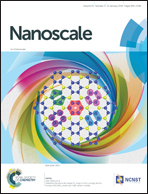Controlled growth of vertically aligned ultrathin In2S3 nanosheet arrays for photoelectrochemical water splitting†
Abstract
This paper reports a facile solvothermal method for the in situ growth of vertically aligned In2S3 nanosheet arrays (NSAs) on fluorine-doped tin oxide substrates. The as-synthesized two-dimensional graphene-like In2S3 nanosheets show an ultrathin thickness down to 3.7 nm consisting of the duodenary interplanar spacing of the (222) plane and a tunable bandgap varying from 2.32 to 2.58 eV. The film thickness and nanosheet density of the In2S3 NSAs can be adjusted by varying the reaction time and precursor concentration. The In2S3 NSAs with a higher film thickness exhibit relatively higher photocurrent due to their stronger light absorption as well as larger surface area for sufficient charge separation and redox reaction. The photoelectrochemical performance of the In2S3 photoanodes can be greatly enhanced by constructing an effective heterojunction with ZnO to promote the photocarrier separation. The In2S3/ZnO NSAs have demonstrated an optimal photocurrent density of 349.1 μA cm−2 at 1.2 V vs. RHE and a maximum incident photon to current efficiency of 10.26% at 380 nm, which are 13.5 and 38 times higher than those of the pristine In2S3 counterparts, respectively.



 Please wait while we load your content...
Please wait while we load your content...